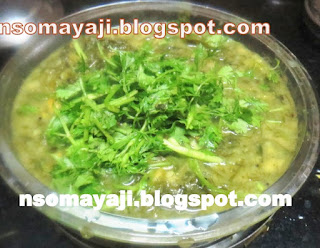Ondelaga/ Gotu Kola is one of the healthy medicinal plant and we do make use of the leaves. We can prepare Tambuli (South Canara /Malenadu Karnataka Special side dish. We can prepare chutney using this leaves. Ondelaga leaves are good for hair, skin and has loads of medicinal properties and good for our health.
Many a times Ondelaga/Timire is called as Brahmi leaves. But they are not. Brahmi leaves are different from Ondelaga leaves.These Ondelaga leaves are known as Gotu Kola leaves.
The other common name is Asiatic Pennywort or Indian Pennywort.
Let us know what do they call Gotu Kola in different regions of India
In Kannada it is known as Ondelaga or Timire. ( ತಿಮಿರೆ ಸೊಪ್ಪು ). Ondelaga means only one leaf in a stem. In Telugu it is known as Saraswathi Aku, Tamil - Vallari Kirai. Marati : Karivan or Karivana.
Gujarati : Khanda Bramhi and in Hindi : Bengsang.
The benefits of having Ondelaga /Gotu Kola.
It is good for cough, cold and fever. The leaves are good for digestion and it balances pitta ( Bile ) and kapha / mucus or phlegm. They help to produce healthy sperm. Ondelaga is known to improve the good blood circulation to the mind and improves our intelligence. They are good for liver related disorders. Gotu Kola is a good blood purifier. It helps in good sleep, good voice and rejuvenation. It helps in treating of various diseases.
Let us see the recipe Now :
This Ondelaga /Gotu Kola Butter Milk helps to cool your body and mind. Try and enjoy.
Jeera : 1/2 Teaspoon
Ingh / Asafoetida : A pinch
Pepper Pods : 3 to 4
Salt : As required
Curd : 4 to 5 Tablespoons or little more.
2. Put jeera /cumin seeds. pepper pods, Ondelaga Leaves, salt and curd to a mixi jar.
3. Add 1 Cup of water and grind all the ingredients nicely till everything mixes well.
4. Pour it to a big bowl. Add some more water and mix it nicely.
5. Shift the ready Ondelaga / Gotu Kola Butter Milk to serving glasses and serve.
6. Adding Ice cubes are optional. ( I have not added ).
Time : 10 Minutes.
Many a times Ondelaga/Timire is called as Brahmi leaves. But they are not. Brahmi leaves are different from Ondelaga leaves.These Ondelaga leaves are known as Gotu Kola leaves.
The other common name is Asiatic Pennywort or Indian Pennywort.
Let us know what do they call Gotu Kola in different regions of India
In Kannada it is known as Ondelaga or Timire. ( ತಿಮಿರೆ ಸೊಪ್ಪು ). Ondelaga means only one leaf in a stem. In Telugu it is known as Saraswathi Aku, Tamil - Vallari Kirai. Marati : Karivan or Karivana.
Gujarati : Khanda Bramhi and in Hindi : Bengsang.
The benefits of having Ondelaga /Gotu Kola.
It is good for cough, cold and fever. The leaves are good for digestion and it balances pitta ( Bile ) and kapha / mucus or phlegm. They help to produce healthy sperm. Ondelaga is known to improve the good blood circulation to the mind and improves our intelligence. They are good for liver related disorders. Gotu Kola is a good blood purifier. It helps in good sleep, good voice and rejuvenation. It helps in treating of various diseases.
Let us see the recipe Now :
This Ondelaga /Gotu Kola Butter Milk helps to cool your body and mind. Try and enjoy.
Ingredients :
Ondelaga /Timire /Gotu Kola Leaves : One handful : 10 to 15.Jeera : 1/2 Teaspoon
Ingh / Asafoetida : A pinch
Pepper Pods : 3 to 4
Salt : As required
Curd : 4 to 5 Tablespoons or little more.
Method :
1. Clean and wash only the leaves. ( Some time the stems are hard to grind and they remain as the stick. So it is better to use only the leaves).2. Put jeera /cumin seeds. pepper pods, Ondelaga Leaves, salt and curd to a mixi jar.
3. Add 1 Cup of water and grind all the ingredients nicely till everything mixes well.
4. Pour it to a big bowl. Add some more water and mix it nicely.
5. Shift the ready Ondelaga / Gotu Kola Butter Milk to serving glasses and serve.
6. Adding Ice cubes are optional. ( I have not added ).



















































